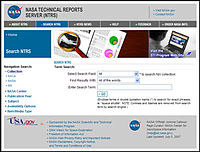- NASA STI Program
-
The Scientific and Technical Information Program Office (STIPO) of the National Aeronautics and Space Administration (NASA) collects, organizes, preserves, and releases the Agency's scientific and technical information (STI). STI is derived from NASA's research and development efforts and NASA projects, programs, and missions. Examples of NASA STI include technical papers and reports, contractor reports, conference papers and proceedings, journal articles, presentations, and technical information on websites. NASA STI also includes research information from NASA's predecessor Agency, the National Advisory Committee for Aeronautics (NACA), which dates back to 1917. NACA transitioned to NASA at the advent of the National Aeronautics and Space Act of 1958 (Amended).[1]
The STI Program Office is funded by the NASA Chief Information Officer (CIO) in Washington, DC. The NASA CIO establishes strategic policy and operational measurements for the STI Program Office, which is located at NASA's Langley Research Center in Hampton, Virginia. In turn, the STI Program Office oversees the NASA Center for AeroSpace Information (CASI), a contractor-maintained and -run facility that collects the NASA STI, organizes it into a large database, ensures that it is preserved via the National Archives and Records Administration, and releases the STI or has the STI released through commercial or other venues, such as science.gov[2] and USA.gov [3] for NASA.
STIPO's charter exists so that NASA STI is as widely released and available as possible and can be leveraged by NASA, U.S. businesses, government, the public, and international entities. This allows NASA to comply with e-Government regulations.[4] The STI Program Office also collects nonNASA STI that is pertinent to NASA's missions and activities, including information from NATO's (North Atlantic Treaty Organisation's) Research and Technology Organization. The STI Program Office is also a member of CENDI,[5] which is a partnership of Federal STI managers.
NASA's STI is freely accessible to the public. At the STI website,[6] one can:
- Search NASA STI collections for reports, conference papers, proceedings, journal articles, and other technical and peer-reviewed STI through the NASA Technical Reports Server (NTRS).[7] NTRS has
- More than 500,000 aerospace STI items
- Approximately 90,000 full-text documents
- More than 111,000 images and videos
- Over 12,000 full-text documents from NASA’s predecessor, NACA
- Better understand NASA's technical accomplishments via its annual premiere publication Spinoff[8] and the Spinoff database of successful commercialized NASA technology [9]
- Sign up for RSS feeds [10] (automatic alerts) for technical topics of interest
- Receive bibliographic alert products, such as "Scientific & Technical Aerospace Reports" (STAR) [11] and "Selected Current Aerospace Notices" (SCAN) [12]
- Access NASA's subsets of technical imagery and videos through the NASA Image eXchange (NIX) [13]
- Understand NASA terminology with the NASA "Acronym Listing" [14]
- Access the "NASA Scope and Subject Category Guide" to help you locate NASA information [15]
- Locate publishing aids, such as the "NASA Publications Guide for Authors" [16] and the popular guide, NASA SP-7084, "Grammar, Punctuation and Capitalization: A Handbook for Technical Writers and Editors" [17]
See also
References
- ^ NASA Space Act
- ^ science.gov Website
- ^ USA.gov Website
- ^ e-Government regulations
- ^ CENDI Website
- ^ STI website
- ^ NASA Technical Reports Server
- ^ NASA Spinoff
- ^ NASA Spinoff database
- ^ STI Automatic RSS Alerts
- ^ NASA "STAR"
- ^ NASA "SCAN"
- ^ NASA Image eXchange
- ^ NASA Acronym Listing
- ^ NASA Scope and Subject Category Guide
- ^ "NASA Publications Guide for Authors"
- ^ "Grammar, Punctuation and Capitalization: A Handbook for Technical Writers and Editors"
Categories: - Search NASA STI collections for reports, conference papers, proceedings, journal articles, and other technical and peer-reviewed STI through the NASA Technical Reports Server (NTRS).[7] NTRS has
Wikimedia Foundation. 2010.



